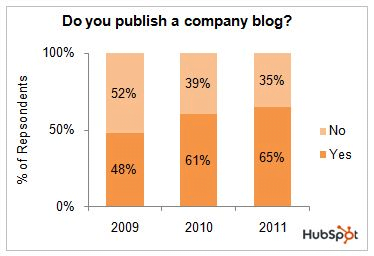 With so many social media studiesshowing that companies are looking to up their involvement in social activities this year, I thought I’d help cure that age-old “what should I blog about today?” question. Or at least give you a healthy head start for the year by providing 100+ potential blog topics for your small business blog. Consider it my contribution to your yearly editorial calendar. I know you’re creating one, right?
With so many social media studiesshowing that companies are looking to up their involvement in social activities this year, I thought I’d help cure that age-old “what should I blog about today?” question. Or at least give you a healthy head start for the year by providing 100+ potential blog topics for your small business blog. Consider it my contribution to your yearly editorial calendar. I know you’re creating one, right?
So, here are some potential topics. Grab a pen and jot down your favorites. [Or maybe just hit Print.]
Focus on your Industry
- Write 10 ways your industry will change this year
- Break down the new laws that will affect your niche in the coming year
- Create a list of the best industry resources
- Talk about why things are better today (or not) than they were 10 years ago
- Attend industry events and blog about them
- Your best marketing tips
- How your industry is like Your Favorite TV Show [I suggest using Glee. Because that’s my favorite show.]
- The ugly truth about your industry
- The 8 people in your industry you want to meet
- What someone needs to consider before getting involved in your industry
- Comment on an industry-related conversation going on in LinkedIn or Google Groups
- Talk about the “thing” that would rock your industry if invented or put together
- Create a chart that breaks down a complicated industry issue or problem
- Interview someone well-known in your world and profile them
- Rewrite an old post with fresh eyes and new ideas
- Publish a presentation you gave somewhere else (with permission)
- Have a chat with a competitor and blog about it (again, with permission)
- Search Google News for relevant press releases and news about your industry. Write your own take.
- Debunk a long-standing myth
- Host a seminar or meetup and blog about
- Create a list of the 10 books that someone in your industry should read.
- Post about what you’d like to see fixed in your industry
- Conferences people in your industry should attend/speak at
- Your favorite untapped traffic sources in your industry
- Issues in your space that deserve more attention
Go Social
- How you’re using Twitter to increase earnings
- Post a video that has nothing to do with your industry but that you think people would enjoy.
- Post a picture. [Browse StumleUpon for inspiration]
- Participate in a blog meme like last month’s Best of 09
- Share the best social media campaigns you’ve seen, big and small
- Hold a contest and pit people against each other
- Create a poll. Blog the result.
- Invite a guest blogger to post on your blog
- How social media increased your ROI this year
- How social media did nothing but confuse you this year
- Search Delicious for popular posts on your topics and take a new stance
- Go to your industry’s Wikipedia page and see what people are talking about in the Discussions area. Comment on it on your blog.
- Post photos from your company party/team building workshop
- Find a question on Yahoo Answers or OnStartups and respond on your blog
- Create a list of the Must Follow Twitter people in your industry
About your Business
- Why you’re different (and better) than your competition
- A video tutorial showing how to use your most popular product
- The problems your sales people hear about most
- The answer to the most common email you get
- Share the tools do you use to do your job
- The secret ways to use your site/product
- The top 10 WordPress plugins you use on your site
- How you use your favorite social media site
- How you built your email list
- How you’re using Facebook
- Look at your site logs & answer customer questions
- How you delegate tasks (or what you mucked up by not delegating)
- Use Wordtracker’s Keyword Question Tool and answer popular questions
- Write about why you’re not using social media at all
- Answer questions left in your comment section
- Write about the personal branding tactics you use
- Give 5 reasons to sign up to your email newsletter
- How you learned to do what you do
- Create a list of your favorite X
- What you’re doing to beat the summer slump or winter blues
- Share a case study
- Provide an end of the week link roundup
- Review something
- Reveal the best niche blogs to guestblog for
- What keeps you up at night
- Share a time when you got it wrong in 2010
- Your strategies for coming up with blog topics.
- Branding tips that have worked for your business
- 50 reasons why someone should hire you
- 5 things people should be focusing on but aren’t
- What can other industries learn from yours
Highlight Your Customers
- Put the spotlight on your most active commenters
- Praise your best customers
- Post a question and let the community to answer it
- How customers can woo your customer service department for free stuff
- Give something away to one of your blog readers.
- Feature a video detailing a customer’s success with your product
- Share your biggest screw up with a customer and how you made it right
- Publish a customer testimonial
- Explain the benefits of being a customer
- Share local organizations you support and ask customers to share their favorites
- How customers can connect with you on social media
- Hold an event for Twitter followers to meet and blog it
Get Personal
 What have you read lately that inspired/angered you?
What have you read lately that inspired/angered you?- Introduce your staff
- Share the best decision you made as a SMB
- Your biggest challenge as a SMB owner
- What you love best about being a SMB owner. What you don’t like.
- The danger of doing everything by yourself
- Write about the achievement you’re most proud of
- A time when you got it right in 2009
- Create a video introducing your team to your community
- Get your rant on
- How to remain productive working at home
- Introduce a new employee and what they bring to the table
- Share the local vendors you trust
- Give people a video tour of your building
- Describe your company culture
- Your new baby (whether that’s a real baby, a pet, a new project for 2010, the car you’ve been restoring for the past two years, etc)
- Share your company’s history or story
- Tell a story not about your company
- Share 10 things you’re thankful for
- What’s next for your company
- A list of your most trafficked posts
The point is, there are TONS of things for a small business owner to blog about and share with their audience. Now that I’ve helped get the ball rolling, get to it. 😉
[“Source-smallbiztrends”]














/https%3A%2F%2Fblueprint-api-production.s3.amazonaws.com%2Fuploads%2Fcard%2Fimage%2F753944%2F61e50a7d-64f2-4004-9a11-9939c39202ff.jpg)





/arc-anglerfish-arc2-prod-shropshirestar-mna.s3.amazonaws.com/public/CAVSZVJW7BAE3GY5NOWNJHKNV4.jpg)
/arc-anglerfish-arc2-prod-shropshirestar-mna.s3.amazonaws.com/public/2COIK6KJEJBYTEA2XU2C2Z6J5Y.jpg)
/arc-anglerfish-arc2-prod-shropshirestar-mna.s3.amazonaws.com/public/KGRBCTCISBD3JA5Q2X55KKDNGU.jpg)










